Convection chicken, roast to perfection is sure to impress and is so easy to prepare. Roasting in a convection oven is the best way to get crispy golden skin, savory dark meat and tender white meat, with no basting required. And, it takes less time to cook than in a conventional oven.
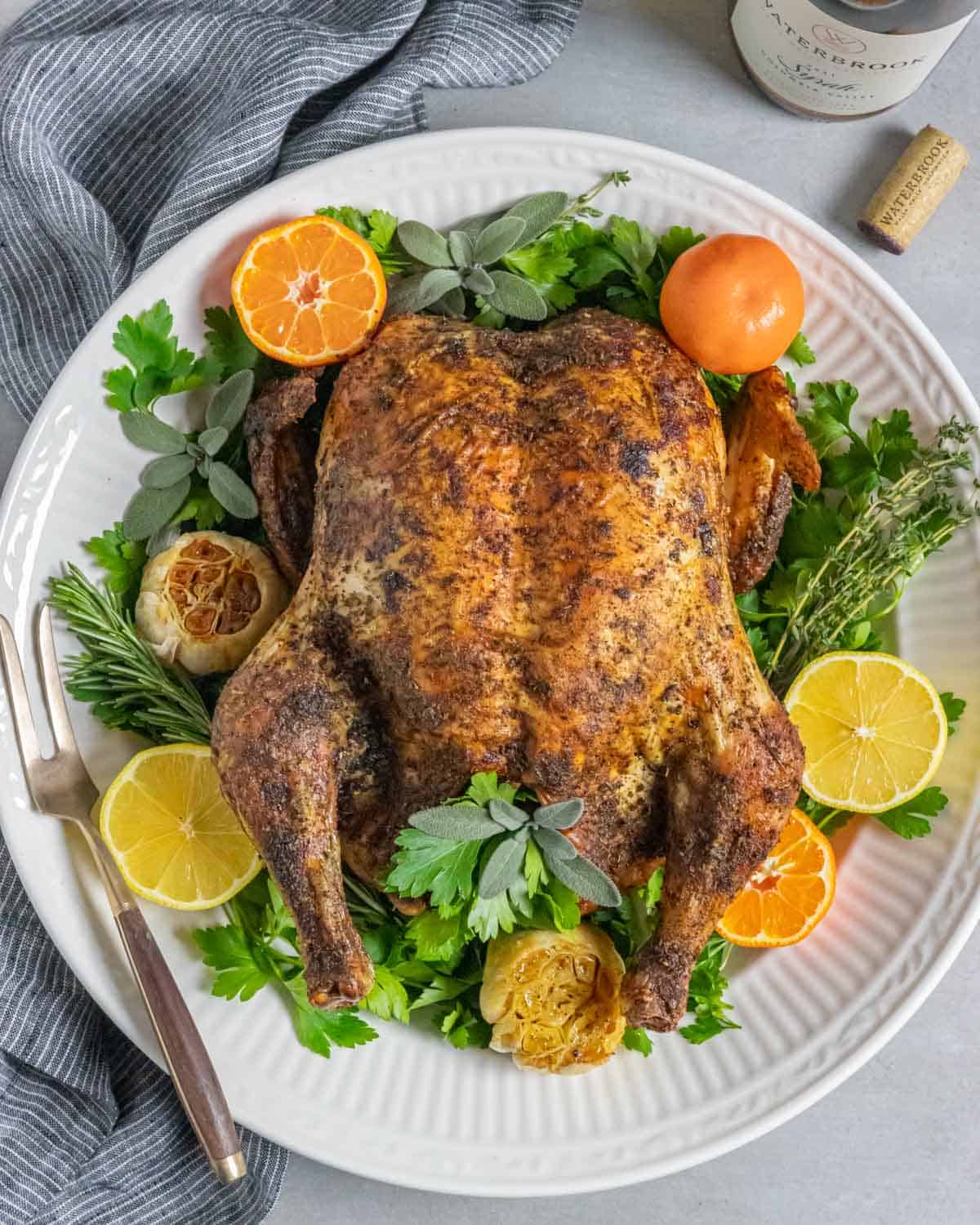
Jump to:
- Conventional oven vs convection oven
- Cooking time for chicken in convection
- What temperature to roast chicken on convection?
- How much chicken per person?
- Ingredients
- How to defrost chicken
- Stuffing a chicken
- At what temperature is a whole chicken done?
- Is chicken low-FODMAP?
- Is chicken keto?
- Instructions
- Expert tips
- Resting time for chicken
- How long does cooked chicken last in the fridge?
- Chicken leftovers ideas
- What to do with the carcass and leftover bones
- Variations
- FAQ
- What to serve with roast chicken
- 📖 Recipe
- 💬 Comments
Convection oven chicken is the most mouthwatering centerpiece for any dinner table. It’s so simple to use your convection oven to make a stunningly delicious, golden brown, crispy skin chicken. It’s never been easier to roast a whole bird and this recipe makes the best, most succulent, flavorful meat I’ve ever had the pleasure of eating.
Whether you choose to cook a bird for a weeknight meal, Sunday dinner or roast a holiday chicken for a small gathering, this will surely be the highlight of the table.
Nothing beats convection for roasting poultry. If your cooking for a large holiday gathering, make it extra special with this perfectly roasted and juicy Convection Oven Roasted Turkey recipe.
Conventional oven vs convection oven
Unlike a conventional oven, a convection oven works very similar to an air fryer. It circulates hot air around the food, providing even cooking. Roasting chicken convection style means a faster cooking time – up to 30-40% faster than in a conventional oven, which relies on heating elements to create radiant heat, with little to no air circulation.
Having air circulating around the food eliminates ‘hot spots’. As the air moves around the bird, it sears the skin and locks the moisture in, making the best juicy white and dark meat – all without basting or brining.
Convection ovens have an exhaust system that vents moisture out of the oven, helping to create that crispy chicken skin everyone craves.
Cooking time for chicken in convection
The size of your bird, and whether you have stuffed it, will affect the cooking time. As a general rule, allow 12 minutes of cooking time per pound. For example, a 4 pound bird, loosely stuffed with aromatics, will take approximately 50 minutes when baked on convection at 350°F.
Over-stuffing the cavity will reduce air circulation, and increase cooking time. USDA says it is essential to use a food thermometer to make sure the stuffing and the meat reach an internal temperature of 165°F.
What temperature to roast chicken on convection?
I find 350°F to be the best temperature to make a succulent bird.
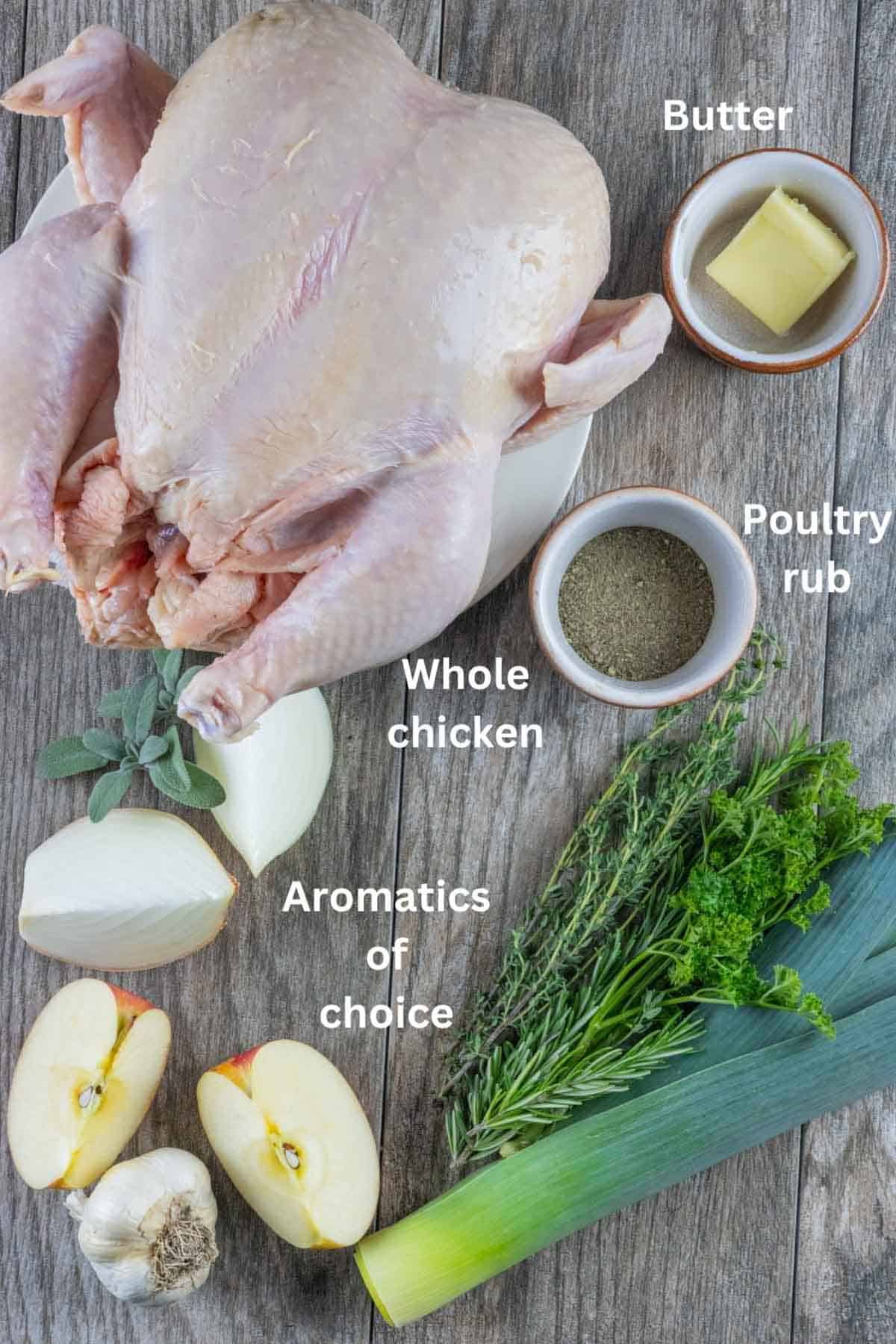
How much chicken per person?
When determining what size bird to buy, plan on about .75 pounds of raw chicken per person. That may seem like a lot, but there is a significant amount of the bird that is bone and will not be eaten. For example, a 4-5 pound bird will yield about 6 servings.
Ingredients
- Whole chicken – be sure it’s fully thawed for best results
- Butter – adds flavor, holds the dry rub onto the skin and creates a golden, crispy skin
- Poultry rub – I like to use my homemade all-purpose seasoning, it's a great seasoning for chicken. If you are looking for substitutions for poultry seasoning, I suggest using a combination of sage, basil, oregano, rosemary, garlic and onion powder (omit for low-FODMAP), salt and pepper. Or, try this savory Buffalo Chicken Dry Rub for incredible color and flavor.
- Fresh aromatics – to put in the cavity during roasting. The flavors steam and infuse into the meat. See below for my favorite aromatics to use.
How to defrost chicken
There are two preferred ways to thaw frozen chicken: under refrigeration or using a cold water defrosting method.
In the refrigerator – The best method is to thaw under refrigeration to prevent bacterial growth. It takes about 24 hours for each 5 pounds. To thaw a 4-5 pound bird, it will take approximately 24 hours in an uncrowded refrigerator. If your fridge is full, add an extra day. After thawing, it will stay safe for another one to two days before cooking.
Submerged in cold water – This method is faster, taking approximately 30 minutes per pound. However, you need to change the water every half hour to maintain proper temperature. Cook the bird immediately once thawed.
USDA recommendations for thawing poultry include thawing in the microwave. However, microwaving to thaw may change the texture of the meat and can even partially cook some parts, so I don't recommend this method.
Stuffing a chicken
Not sure what to stuff a chicken with?
Aromatic herbs, fruits and vegetables are the best options to place in the cavity for roasting. Aromatics infuse the meat with so much flavor and the seared skin from convection cooking holds in the moisture and flavor.
My favorite fresh aromatics to use are:
- Onion or leek
- Parsley
- Garlic cloves
- Apple or pear
- Orange or lemon wedges
- Rosemary
- Thyme
- Sage
- Carrot
- Celery
Place the aromatics in the cavity, leaving some head room. Remember, the more stuffing you put into the bird, the longer it will take to cook.
You can also fill the cavity with a savory stuffing mixture. It will take longer to cook the bird and you must make sure the stuffing is at least 165°F before removing from the oven. My preference is to put aromatics inside the cavity and cook any stuffing separately.
At what temperature is a whole chicken done?
The USDA recommends that internal temperature of poultry reach 165°F. Internal temperature of baked chicken is determined by inserting a meat thermometer into the thickest part of the thigh and breast, without touching bone. It’s best to test the temperature in multiple places on the bird. Any stuffing or aromatics must also be checked to ensure they have reached 165°F.
Is chicken low-FODMAP?
Yes, absolutely! It is only protein and fat and doesn’t contain any carbohydrates that can cause digestive upset.
This is one of my favorite low-FODMAP chicken recipes – just use aromatics that are FODMAP-friendly and you’ll have the most delicious low-FODMAP roasted chicken ever.
Is chicken keto?
Yes, it is keto-friendly and can be considered a staple food for a keto diet. It’s a great source of high-quality protein and fat, especially when choosing a pasture-raised bird. Pasture-raised chicken is higher in omega-3 fatty acids than grain-fed only.
Instructions
Learning how to prepare and roast a chicken in a convection oven is very simple:
Preheat oven to 350°F on convection setting.
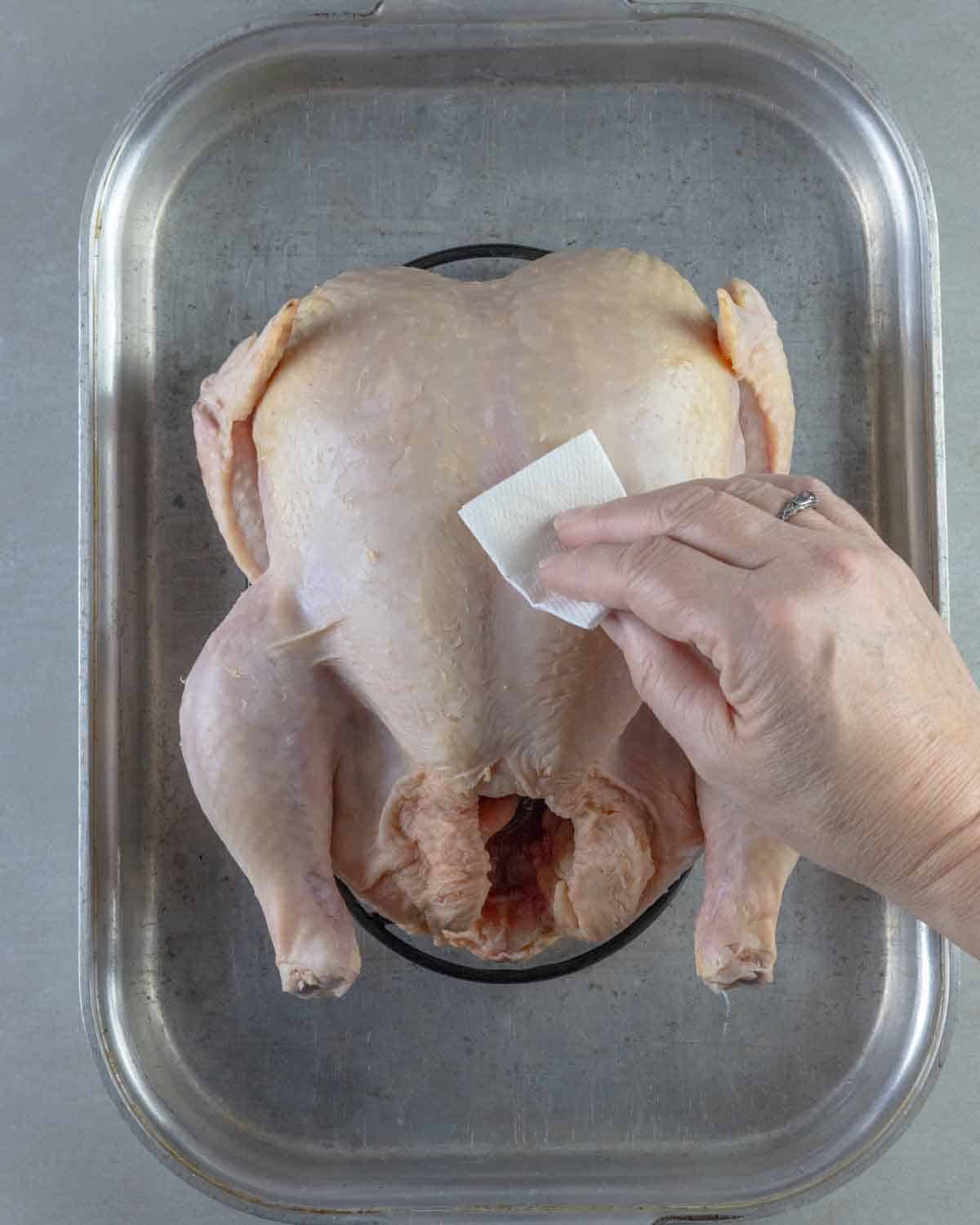
Pat the skin dry. This allows the butter to adhere to the surface.
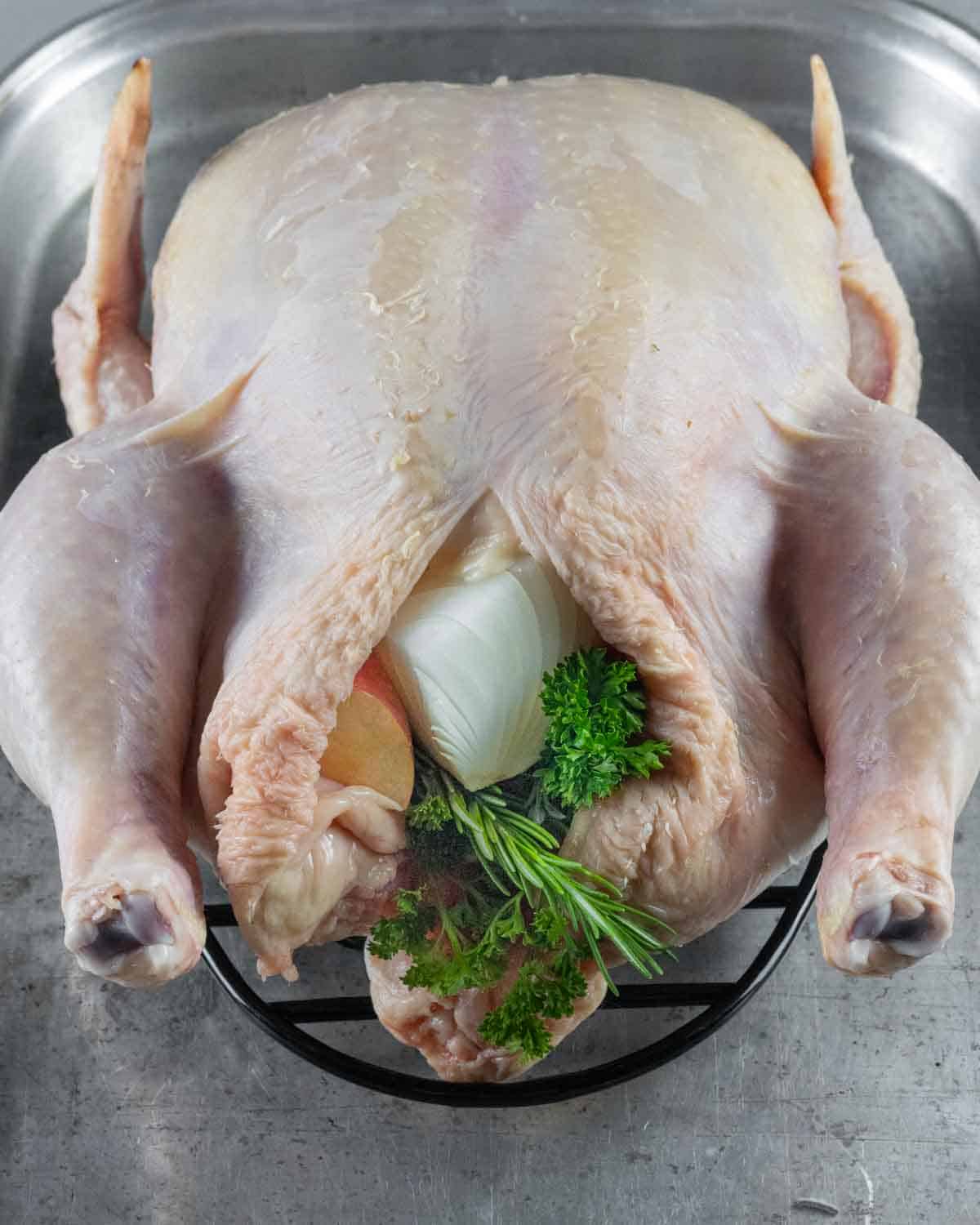
Season the cavity with rub and stuff with aromatics.
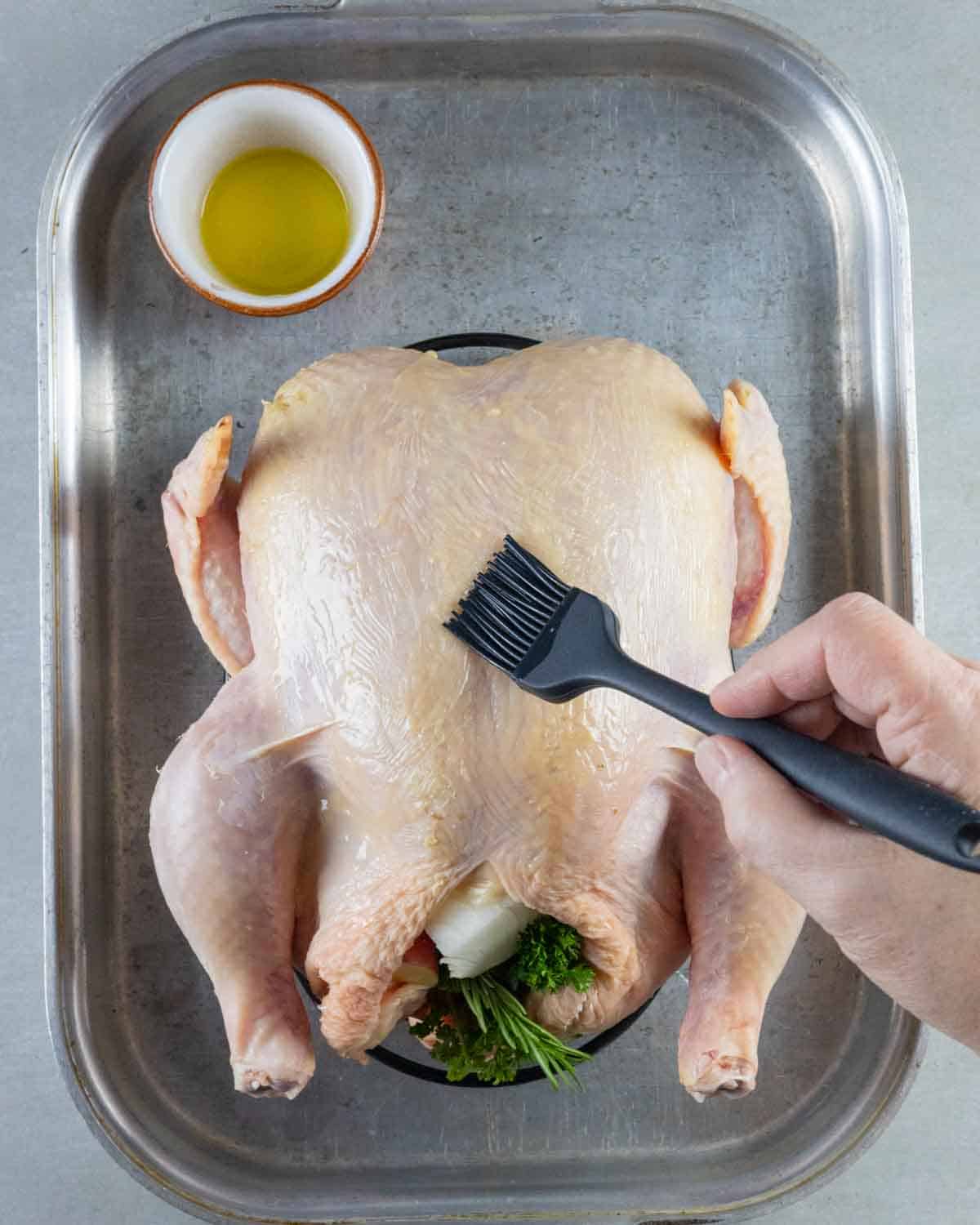
Brush with melted butter.
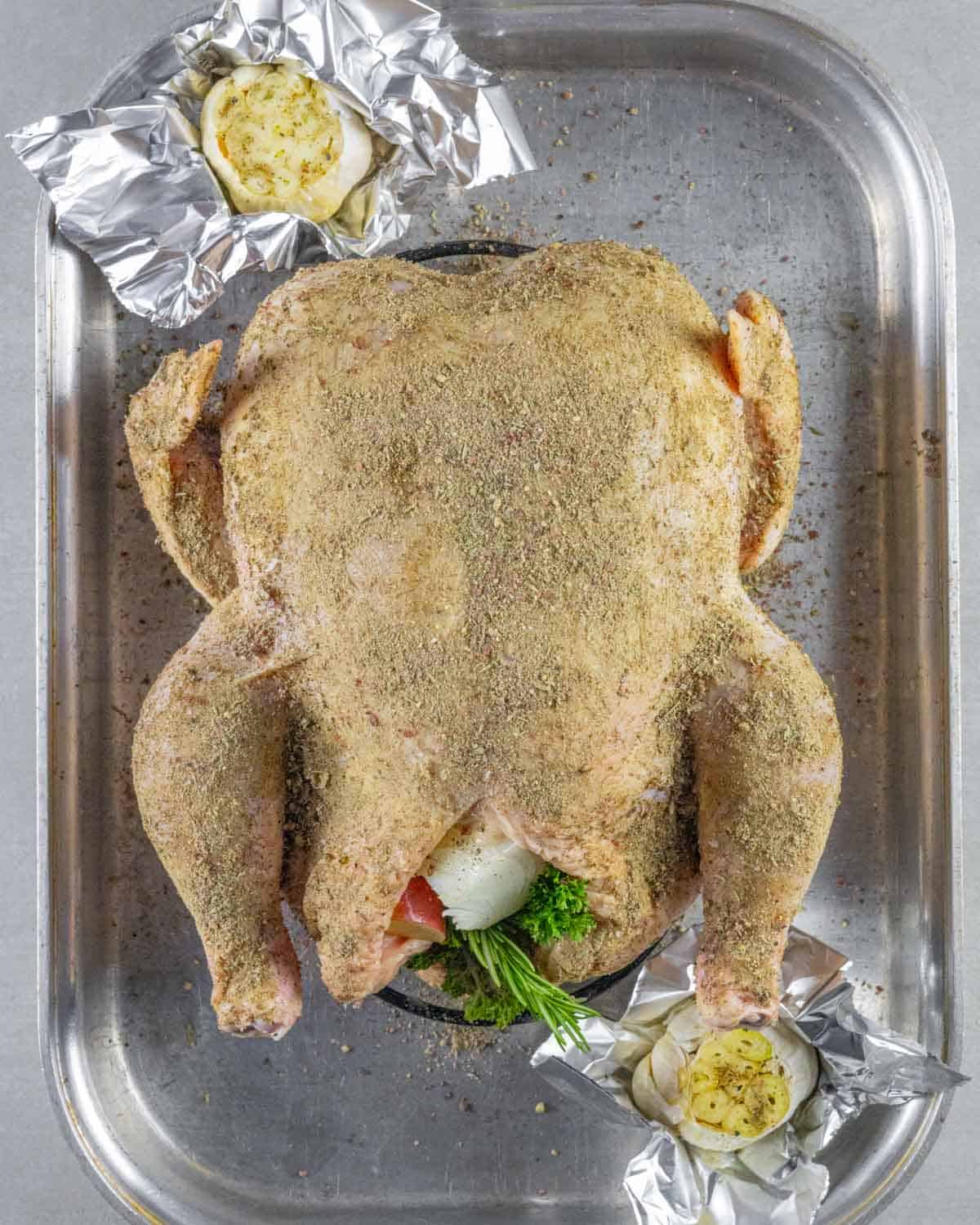
- Sprinkle rub over the buttered skin
- Place on a roasting rack (if using), with the chicken breast side up, and place in the roasting pan
- Note: I like to take this opportunity to roast some garlic if there's room in the pan!
- Place on the center rack of the pre-heated oven
- When the internal temperature reaches 165°F, remove from the oven.
- Let rest for 10-15 minutes before carving
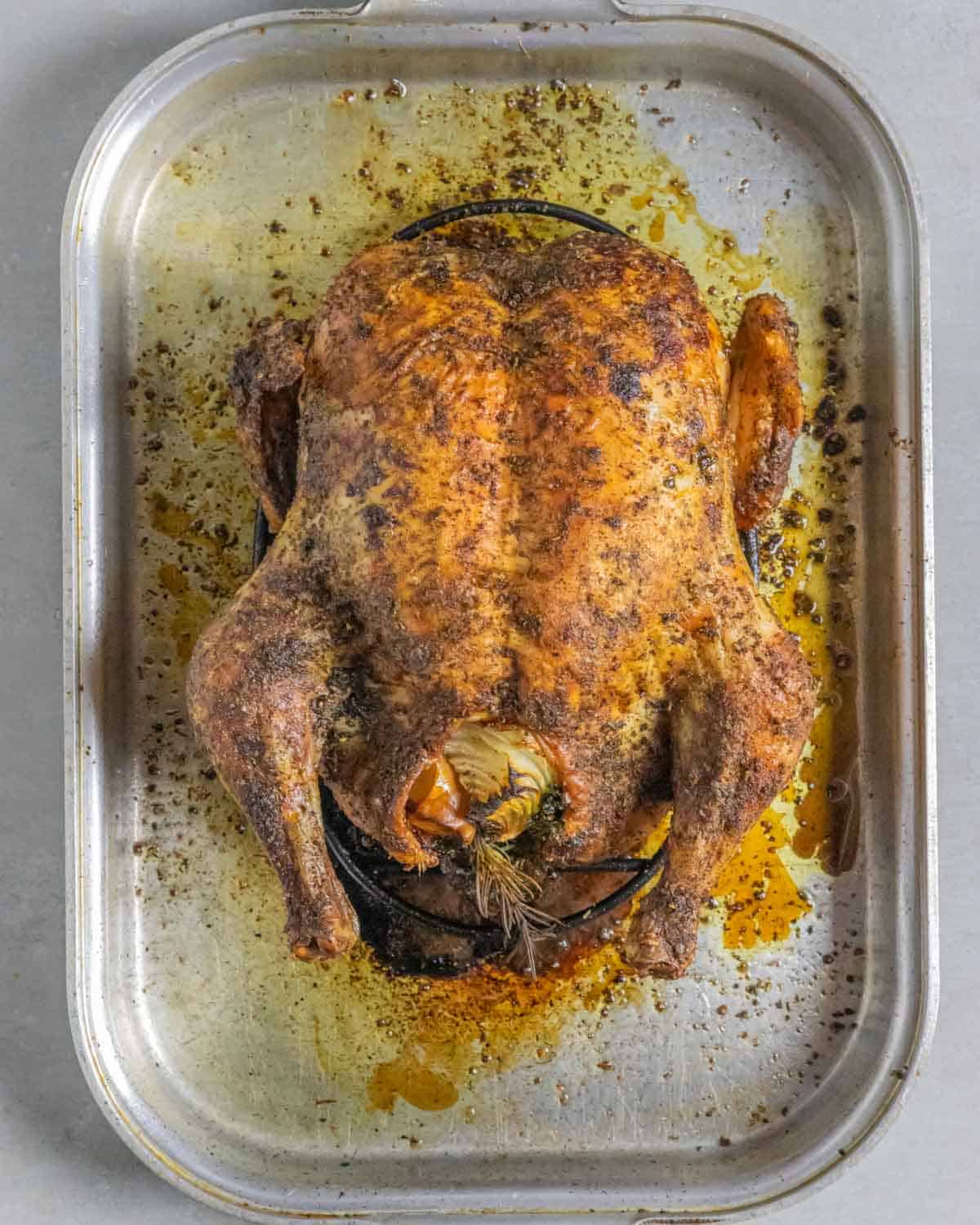
Expert tips
- If you begin to see areas of the skin getting too brown, cover those areas with foil to help protect them during cooking.
- Always start with a fully thawed bird. If it's slightly frozen on the inside, you can use the cold water thawing method to finish the thawing process. If the bird is still partially frozen when going in the oven, the exterior will get overcooked by the time the interior temperature reaches 165°F.
- Use a cold chicken for best results. It does not need to reach room temperature before preparing. The melted butter should have the opportunity to harden a bit on the skin before applying the rub.
Resting time for chicken
It’s best to rest the bird for 10-15 minutes before carving. Tent with foil and let sit at room temperature. The internal temperature will continue to rise during part of the resting process, called carryover cooking. When the temperature begins to fall, the juices will re-absorb into the muscle fibers, making the meat tender and juicy. Resting also makes it easier to carve.
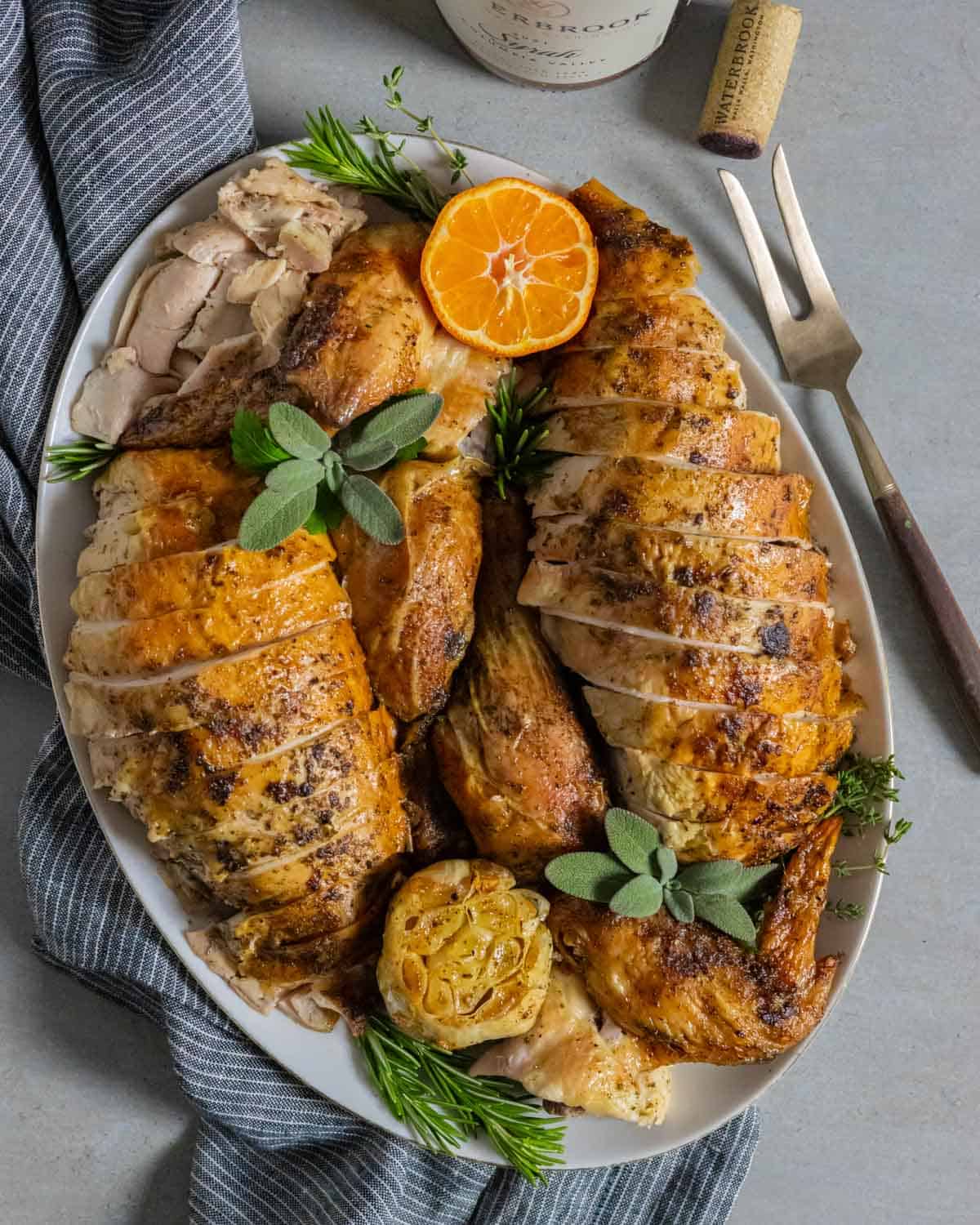
How long does cooked chicken last in the fridge?
When stored in a sealed, air tight container, it can last up to 4 days in the refrigerator. Refrigeration slows bacterial growth at 40°F or less, but does not stop it. Freeze the leftovers if you won't consume them within 4 days.
Chicken leftovers ideas
- Chicken taco soup – leftover meat makes wonderful soup! If you love the flavor of tacos, you’ll love this recipe!
- Add to salads – try shredded, chopped or sliced chicken on a Kale BLT Salad or add to a Fattoush Salad
- Chicken tacos – make tacos seasoned with Homemade Taco Seasoning and top with Radish Salsa or Pineapple Habanero Salsa
- Chicken salad – finely chop the meat and add mayo, seasonings, cranberries and chopped pecans or walnuts. Or, make it a Spicy Chicken Salad with Jalapeños and Artichokes.
- Easy pasta dinner – use leftovers to make a delicious one pot Marry Me Chicken Pasta dish
What to do with the carcass and leftover bones
Make broth, of course! See my recipe for how to make homemade bone broth to make the best soups and stews. Or, just warm it up and drink bone broth for its health benefits.
If you don’t want to use them immediately, package the leftover bones in a freezer bag and save for later. You don’t even need to thaw them before making broth. Just put them in the pot with water and herbs and cook.
Variations
- Greek roasted chicken – to roast chicken Greek style, use olive oil in place of butter and top with oregano and garlic powder (for low-FODMAP use garlic-infused olive oil). Slice lemons and put inside with more fresh oregano and garlic cloves.
- BBQ style – replace the poultry seasoning with your favorite BBQ rub, like a sugar-free Keto BBQ Seasoning, an amazing savory Coffee Rub Seasoning or a low-FODMAP BBQ Rub that doesn’t contain onion or garlic
- Buffalo – use this Buffalo Chicken Dry Rub to make a buffalo style roast
- Rotisserie style – add paprika and a touch of cayenne to the all-purpose seasoning
- Roast Christmas Chicken – for a small holiday gathering, a small bird is a great choice. To add a festive flavor, add cranberries to the list of aromatics to stuff in the cavity. These add a sweetness to the meat as they macerate with the other herbs and spices.
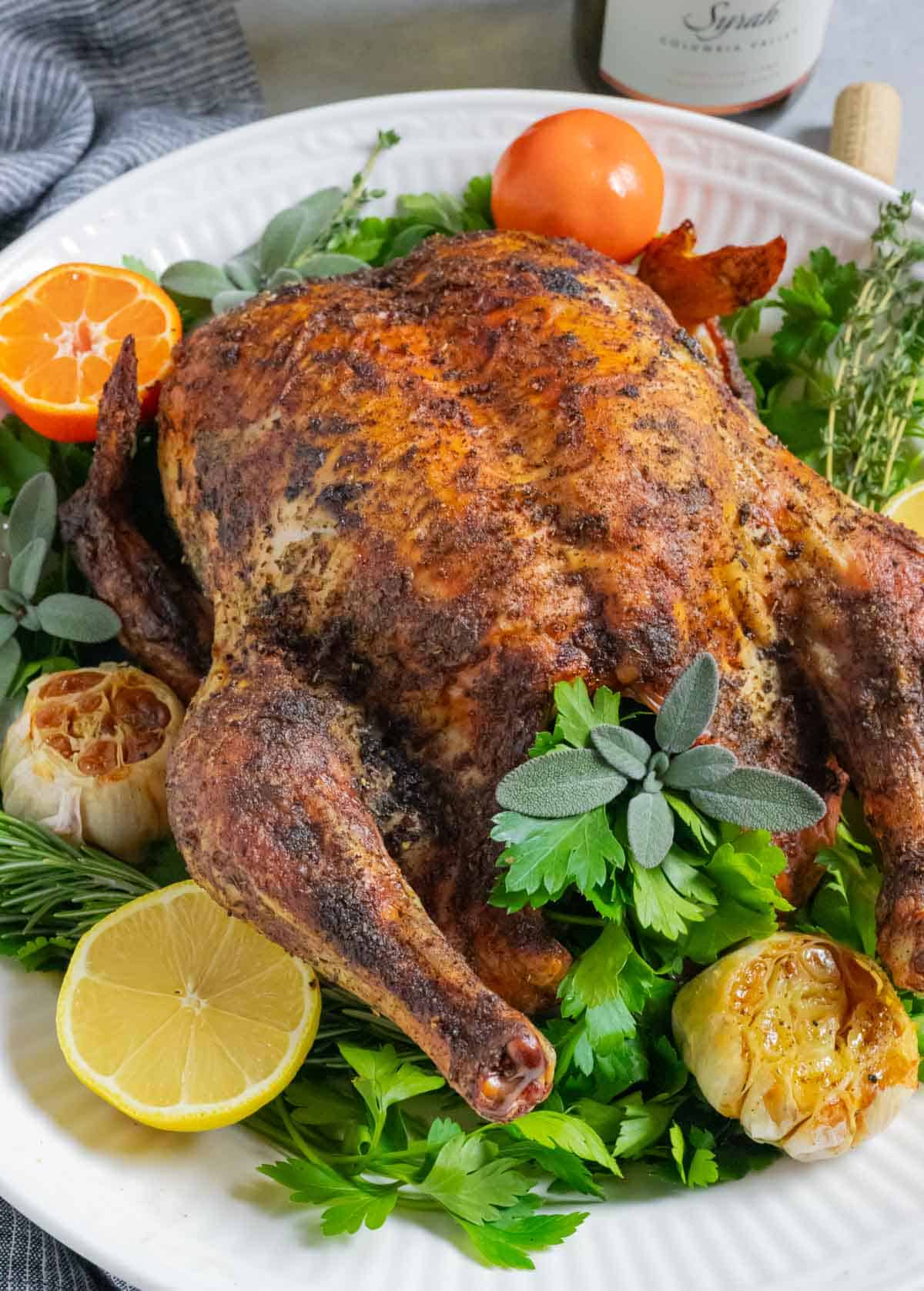
FAQ
No – trussing with kitchen twine is not necessary. If you like the look, then truss the legs. There’s no benefit either way – it’s all about aesthetics.
No – you do not need to brine before roasting. The convection oven will crisp and seal the skin, holding in all of the juices.
A roasting rack isn't neccessary, but it's a good idea. When cooking a chicken in a convection oven, having the bird elevated allows for air to circulate, ensuring even cooking. If you don’t have a roasting rack, you can use a sheet pan and a wire cooling rack to keep the bird above the bottom of the pan.
No - this is not recommended. Meat and poultry should not be thawed in hot water. As soon as any thawed part of the meat reaches 40°F, it enters a danger zone where bacteria begin to grow. It should be kept at a safe temperature, below 40F while thawing.
Yes – in fact it freezes very well. It can be frozen for up to 6 months. If it’s frozen longer, it can lose its moisture and flavor.
No – you do not and should not rinse your raw chicken unless it has been sitting in a brine solution. Washing chicken provides no benefits for food safety or cooking. In fact, if you wash chicken, it can spread bacteria (cross-contamination) to your kitchen through juices that may splash onto surfaces and utensils.
The only time you should rinse the bird is if you have soaked it in a brine. Rinsing after brining helps to remove excess salt from the surface of the skin and meat.
📖 Recipe
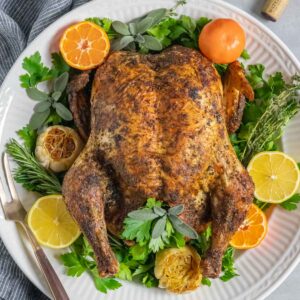
Convection Oven Roast Chicken
Ingredients
- 1 whole chicken
- 2 tablespoons butter (based on a 4-5 pound bird)
- 2 tablespoons chicken rub (try this All-Purpose Seasoning or use your favorite poultry rub.)
- 2 cups fresh aromatics (whole herbs, spices, fruit and vegetables. See Stuffing a Chicken in post for recommendations.)
Instructions
- Preheat oven to 350 °F on the convection setting.
- Pat the skin dry. This allows the butter to adhere to the surface.
- Season the cavity with poultry rub and stuff with aromatics.
- Brush the surface with melted butter.
- Sprinkle rub over the buttered skin.
- Place on a roasting rack (if using), with the chicken breast side up, and place in the roasting pan.
- Optional: Truss the chicken. Tie the legs together with kitchen twine. This is more for visual appeal than anything. It will cook evenly whether trussed or not.
- Bake on convection on a center rack until the internal temperature of the stuffing and the thickest portion of the thigh and breast (without touching the bone) all reach 165℉. This will take between 50-90 minutes depending on the size of the bird and how much the cavity is stuffed. See Cooking Time in post.
Notes
Expert tips
- If the skin begins to get too browned, cover those areas with foil during the cooking process. If you turn off the convection setting and simply use the roast setting, the temperature in the oven will decrease and the bird will take longer to cook.
- Start with a fully thawed bird. If it's slightly frozen on the inside, you can use the cold water thawing method to finish the thawing process. If it is still partially frozen when going in the oven, the exterior will get overcooked by the time the interior temperature reaches 165°F.
- Use a cold bird for best results. It does not need to reach room temperature before preparing. The melted butter should have the opportunity to harden a bit on the skin before applying the rub.
Resting time
It’s best to rest the bird for 10-15 minutes before carving. Tent with foil and let it sit at room temperature. The internal temperature will continue to rise during part of the resting process, called carryover cooking. When the temperature begins to fall, the juices will re-absorb into the muscle fibers, making the meat tender and juicy. Resting also makes the bird easier to carve. See post for more information on Thawing, Stuffing, How long to Cook, Leftovers Ideas and How to Use the Carcass.Nutrition
*Net carbs = carbohydrates - fiber
Nutritional information is an estimate, calculated using online tools and does not include optional ingredients unless otherwise indicated.


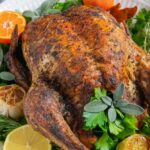
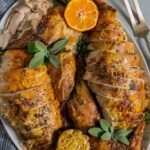
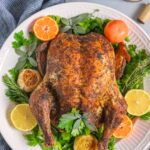

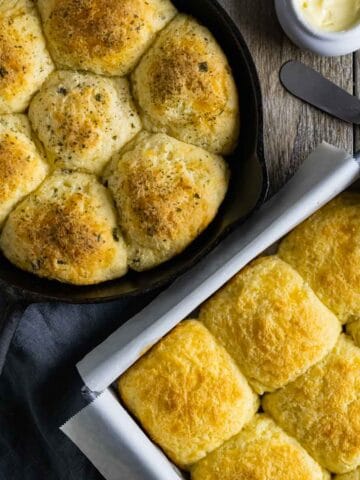
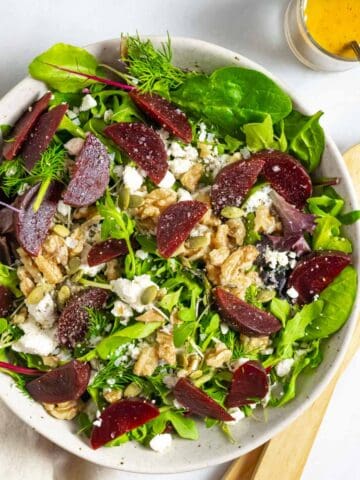
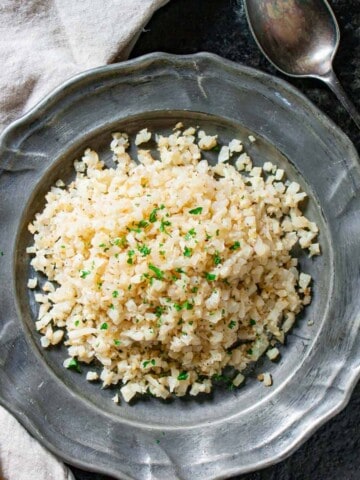
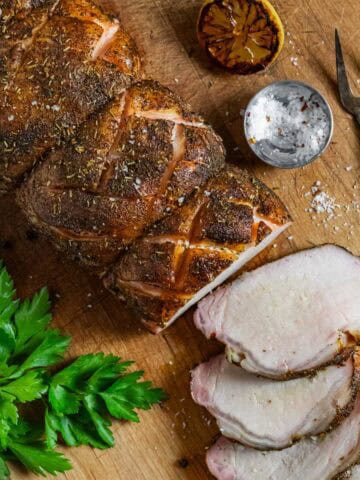
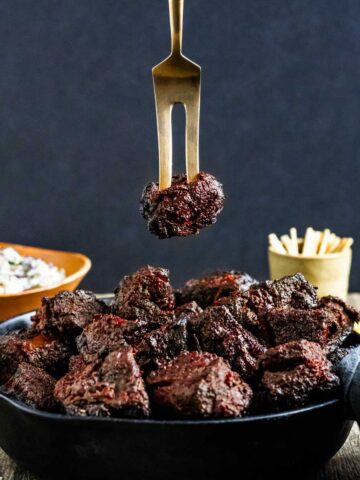
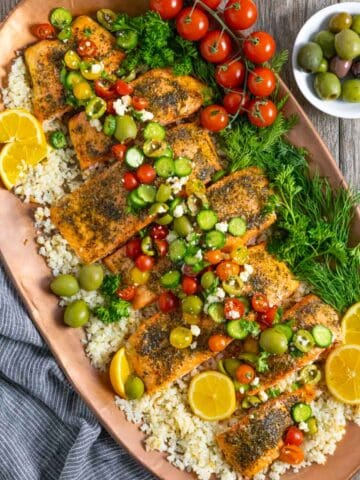
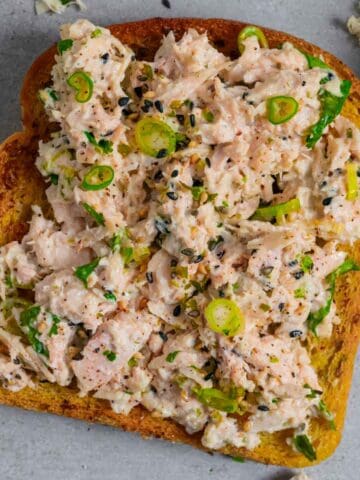
Gerry Davies says
Guess work needs doing as I have a 6 1/3 lb chicken. Should make some adjustment device for size. Going with 12 per pound…we shall see!
Tracey Hatch-Rizzi says
Hi Gerry,
Yes, that's exactly right. The 12 minutes per pound is just a guideline, but you may find that it cooks faster or slower based on your oven and whether it's stuffed or not. For your chicken, I would estimate about 75 minutes of cook time at 350°F. But you're cooking to temperature rather than time, so it would be a good idea to temp your bird around the 1 hour mark.
Best,
Tracey
Dave says
I think this was the best chicken of my life.
Tracey Hatch-Rizzi says
Hi Dave,
Ohmygosh, I'm so happy you feel that way! It's definitely my favorite way to make chicken.
Best,
Tracey
Pam says
Wow - this was cooked in like 45 minutes with the herbs in it. And it was perfectly moist and tender with perfect skin.
Tracey Hatch-Rizzi says
Hi Pam,
I'm so glad you liked it! This is my favorite way to cook a whole chicken.
Best,
Tracey